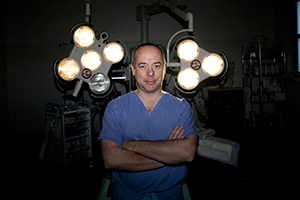
New research led by Professor of Surgery, J. Calvin Coffey, Graduate Entry Medical School, UL and Colorectal Surgeon, University Hospital Limerick (UHL) has refuted a century of mistaken abdominal anatomy by remapping the human mesentery in a way never described before. This research has significant implications for patient outcomes, leading to less invasive surgeries, fewer complications, faster patient recovery and lower overall costs.
Prof Coffey explains: “The blood vessels which supply the gastrointestinal tract (gut) travel through the mesentery - a structure which attaches the intestine to the abdominal walls, and holds it in place and defends against the spread of disease, including cancer. However, for over 100 years the anatomy of the mesentery has been incorrectly described. Our research has found that this critical part of abdominal anatomy is a simpler structure than previously thought, and this is having a major impact across all related scientific and clinical disciplines.”
In collaboration with Professor Peter Dochery and Dr. Fabio Qunadematteo (NUIG), and Professor Colum Dunne (GEMS/UL), the team combined multiple investigatory tools including 3D imaging to fully map the correct anatomical structure of the mesentery. Their findings have recently been published in Annals of Surgery, the premier surgical journal worldwide, as well as in the Journal of Anatomy, The Surgeon, Colorectal Disease and many other journals.
As per Prof Coffey: “Inaccurate understanding of structure has greatly hampered our understanding of this organ. Increasingly we are recognising that the mesentery plays a crucial role in controlling metabolic, immunologic and endocrine functions such that it is now regarded as a driver of disease processes including diabetes mellitus, ischaemic heart disease, and peripheral vascular disease. The recent clarification of mesenteric organ structure will greatly aid pathologists in understanding gastrointestinal diseases, radiologists in interpreting the appearance of abdominal diseases in general, and surgeons in anatomically correcting these diseases. By following these findings, surgeons can now perform abdominal surgery with minimal complications, and trainee surgeons can be trained to perform it in a reproducible manner that heretofore was not possible. ”
Prof Coffey added: “These findings related to structure have provided fresh approaches to diseases such as intestinal cancer, inflammatory bowel diseases including ulcerative colitis, Crohn’s disease and diverticulosis. New mechanisms of cancer spread and progression, as well as novel cellular targets, have been identified. We can now better personalise operations to suit the exact stage of a patient’s disease, including Crohn’s, bowel cancer and a range of abdominal conditions. This has a significant impact on patients as a more accurate understanding allows us opt for less invasive keyhole surgery with minimal blood loss, and, more importantly for the patient, minimal complications. With surgery that adopts the new mesenteric-based principles, previously common complications are now a rarity, patients recover quickly and achieve a normal quality of life faster, leading to savings in healthcare and socio-economic costs.”
This research also has implications for disease treatment, in particular, helping to identify new biological markers that can be used by Oncologists to determine the most appropriate form of chemotherapy for each patient. These findings contribute to a global drive towards more personalised care, helping to identify treatments that will best benefit individual patients. UHL and UL are partnering with world leaders in this field worldwide including the Cleveland Clinic and the Dana-Farber Institute/Harvard Cancer Centre.